Effect of acute exercise on AMPK signaling in skeletal muscle of subjects with type 2 diabetes: a time-course and dose-response study
- PMID: 17327455
- PMCID: PMC2844111
- DOI: 10.2337/db06-1119
Effect of acute exercise on AMPK signaling in skeletal muscle of subjects with type 2 diabetes: a time-course and dose-response study
Abstract
Activation of AMP-activated protein kinase (AMPK) by exercise induces several cellular processes in muscle. Exercise activation of AMPK is unaffected in lean (BMI approximately 25 kg/m(2)) subjects with type 2 diabetes. However, most type 2 diabetic subjects are obese (BMI >30 kg/m(2)), and exercise stimulation of AMPK is blunted in obese rodents. We examined whether obese type 2 diabetic subjects have impaired exercise stimulation of AMPK, at different signaling levels, spanning from the upstream kinase, LKB1, to the putative AMPK targets, AS160 and peroxisome proliferator-activated receptor coactivator (PGC)-1alpha, involved in glucose transport regulation and mitochondrial biogenesis, respectively. Twelve type 2 diabetic, eight obese, and eight lean subjects exercised on a cycle ergometer for 40 min. Muscle biopsies were done before, during, and after exercise. Subjects underwent this protocol on two occasions, at low (50% Vo(2max)) and moderate (70% Vo(2max)) intensities, with a 4-6 week interval. Exercise had no effect on LKB1 activity. Exercise had a time- and intensity-dependent effect to increase AMPK activity and AS160 phosphorylation. Obese and type 2 diabetic subjects had attenuated exercise-stimulated AMPK activity and AS160 phosphorylation. Type 2 diabetic subjects had reduced basal PGC-1 gene expression but normal exercise-induced increases in PGC-1 expression. Our findings suggest that obese type 2 diabetic subjects may need to exercise at higher intensity to stimulate the AMPK-AS160 axis to the same level as lean subjects.
Figures
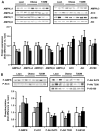
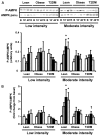

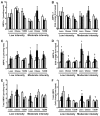
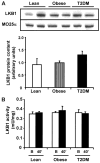
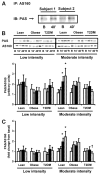
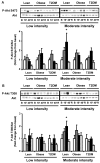

References
-
- Winder WW, Hardie DG. Inactivation of acetyl-CoA carboxylase and activation of AMP-activated protein kinase in muscle during exercise. Am J Physiol. 1996;270:E299–E304. - PubMed
-
- Vavvas D, Apazidis A, Saha AK, Gamble J, Patel A, Kemp BE, Witters LA, Ruderman NB. Contraction-induced changes in acetyl-CoA carboxylase and 5′-AMP-activated kinase in skeletal muscle. J Biol Chem. 1997;272:13255–13261. - PubMed
-
- Hayashi T, Hirshman MF, Kurth EJ, Winder WW, Goodyear LJ. Evidence for 5′ AMP-activated protein kinase mediation of the effect of muscle contraction on glucose transport. Diabetes. 1998;47:1369–1373. - PubMed
-
- Mu J, Brozinick JT, Jr, Valladares O, Bucan M, Birnbaum MJ. A role for AMP-activated protein kinase in contraction- and hypoxia-regulated glucose transport in skeletal muscle. Mol Cell. 2001;7:1085–1094. - PubMed
-
- Musi N, Hayashi T, Fujii N, Hirshman MF, Witters LA, Goodyear LJ. AMP-activated protein kinase activity and glucose uptake in rat skeletal muscle. Am J Physiol Endocrinol Metab. 2001;280:E677–E684. - PubMed

